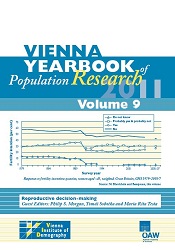
Vienna Yearbook of Population Research 2011, pp. 179-206, 2012/02/02

The gap between fertility intentions and behaviour remains a contentious area of theoretical, methodological and policy debate. Previous fertility studies have focused on individual and institutional characteristics, at the expense of the recognition of meso-level family social capital and networks. This study examines the realisation of time-dependent fertility intentions for the transition to first and higher-order births. Building upon and extending the previous literature we explore two competing theoretical mechanisms of how high levels of family social capital operate to either enable or inhibit the realisation of intentions and the impact of cross-sibling effects. Using two waves of the Netherlands Kinship Panel Survey (NKPS), we also introduce a methodological extension by examining whether the inclusion of only those with positive fertility intentions in previous research has resulted in selection bias. By adopting a probit model with sample selection, we both avoid this selection problem and empirically test whether there is a bias. Results show that there are some, albeit negligible, unobserved characteristics affecting both an individual’s fertility intentions and the realisation of these intentions. High levels of family social capital operate to deter from having a child, particularly when individuals already have at least one child, suggesting that individuals adopt a ‘satisficing’ strategy. Our findings also suggest that children may operate as a means to generate family social capital. Having a sibling with a young child is associated with a higher probability to realise one’s own intention to have a first child.